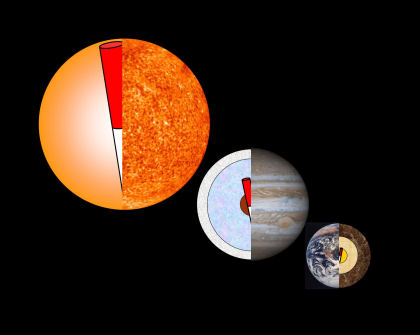Press Release 01/2009 - 8th January 2009
How strong are the magnetic fields of stars and planets?
The magnetic field strengths of quickly rotating stars and planets depend mainly on the amount of energy that these bodies emit into space.
Not only the Earth, but also other planets, the Sun, and many stars have their own magnetic field. The strength of these fields can vary substantially: While Jupiter’s magnetic field is ten times as strong as the Earth’s, the magnetic field of some stars exceeds even this value by a factor of more than a thousand. Until now, an explanation for these differences was missing. Apart from that, different theories were necessary to explain the magnetic fields of stars and planets. Scientists from the Max Planck Institute for Solar System Research and the University of Göttingen in Germany have now proposed a new theory, that applies to all quickly rotating planets and stars. The amount of energy that the planet or star emits into space and its density are decisive. (Nature, January 8th 2009)
Magnetic fields play an important role throughout space: On the Sun’s surface they have a share in creating the solar flares that hurl charged particles into space. The Earth’s magnetic field on the other hand offers an effective protection against this bombardment. All these magnetic fields have in common that they originate deep within the hot interior of the planets or stars. From there, liquid or gaseous material rises to the surface, cools off and sinks back down. Since this material can also conduct electricity, the motion of the carriers creates the magnetic fields. This process is similar to the dynamo of a bicycle. The fast rotation of the planets and stars gives the material currents a form that benefits the dynamo principle.
Until now, scientists believed that the strength of the magnetic field is determined by the velocity with which the planet or star rotates. However, observations of other stars and computer simulations have shown, that this relationship does not hold true for quickly rotating bodies such as the Earth, Jupiter and most stars with a mass considerably smaller than that of the Sun. Above a certain rotation rate the magnetic field strength no longer increases. Depending on the body this critical velocity lies between one revolution per day or one revolution within a few days.

|
The Earth, Jupiter and rapidly rotating stars all generate magnetic fields that resemble those of bar magnets, despite vast differences in the field strength, the size, and internal structure of these objects.
|
(Image: MPS / U. Christensen)
|
Researchers from Germany have now derived a new explanation from computer simulations. According to their theory, the strength of the magnetic field mainly depends on the amount of energy that the planet or star emits into space as heat radiation or light. Part of this energy flux is available within the planet or star to create electric flows and thereby the magnetic field. For the first time, the researchers were able to apply the new law also to stars where density changes with depth.
The new theory is in excellent agreement with the observational data obtained from Earth, Jupiter and 35 quickly rotating stars. "Our results imply, that the dynamo process in planets and stars is not as different as we thought", says Prof. Dr. Ulrich Christensen from the Max Planck Institute for Solar System Research in Katlenburg-Lindau, Germany.
The new results also allow to predict the magnetic field strength of planets whose magnetic field has not yet been detected. Some stars, for example, are circled by planets that are much larger than Jupiter, the largest planet in our solar system. For such planetary giants the scientists predict a magnetic field that is ten times as large as Jupiter’s. According to the researchers these planets should emit intensive radio waves. Although to date no antennae on Earth are sensitive enough to detect this radiation, new facilities like the array LOFAR will be able to measure these waves in the future. LOFAR consists of antennae in the Netherlands, France, Germany, Sweden, and England and will begin operating in the next years. In this way scientists could determine new magnetic fields - and maybe even discover new planets.
Original Publication
U.R. Christensen, V. Holzwarth, A. Reiners
Energy flux determines magnetic field strength of planets and stars
Nature, January 8th 2009
Contact
Dr. Birgit Krummheuer
Public Relations, Press Officer
Max Planck Institute for
Solar System Research
Max-Planck-Straße 2
37191 Katlenburg-Lindau
Tel.: +49 5556 979 462
Mobil: +49 173 39 58 625
Fax.: +49 5556 979 240
Email: krummheuer@mps.mpg.de
Prof. Dr. Ulrich Christensen
Max Planck Institute for
Solar System Research
Max-Planck-Straße 2
37191 Katlenburg-Lindau
Tel.: +49 5556 979 542
Email: christensen@mps.mpg.de
Dr. Ansgar Reiners
Institute for Astrophysics
University Göttingen
37077 Göttingen
Tel.: +49 551 39 13825
Email: areiners@astro.physik.uni-goettingen.de
